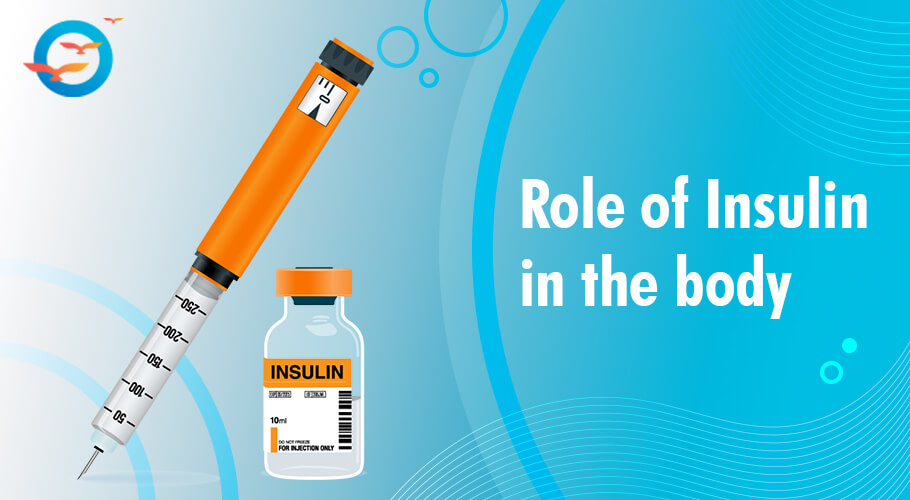Role of Insulin in human body : FFD

Insulin is a hormone produced by beta cells that are situated in the pancreatic islets of Langerhans. The pancreatic beta cells, being sensitive to blood sugar levels, secrete insulin into the blood when glucose levels are high; and slow or stop the secretion if glucose levels are low.
When you eat, the carbohydrate in your food is converted into glucose which floods the blood circulatory system. This excess of glucose prompts the pancreas to secrete insulin. The insulin unlocks cells in the body, allowing glucose to enter the cells, effectively dropping the concentration of glucose in the blood. About 70% of the glucose is used by your muscular-skeletal system, which is why exercise, especially muscle-building resistance exercises are so important for controlling type 2 diabetes.
In addition to regulating blood sugar levels by sending glucose to muscle cells, insulin converts the excess glucose into fat, which is in effect a store for calories. Thus, when there is a surplus of calories—i.e. when you overconsume food—the glucose that is left over after the body’s cells have been filled is automatically converted into fat. Since diabetics generally have higher concentrations of insulin in the body, their tendency to gain weight is also higher. This is also why insulin-dependent diabetics are often overweight or suffer from obesity.
Insulin is needed to enable the body to store glucose in your muscles or liver and convert excess glucose into fat as storage for future energy requirements. Lack of insulin impairs its ability to perform both these functions In its absence, the fat breaks down to create keto acids, which can trigger diabetic ketoacidosis, a potentially fatal condition, if levels grow too high.
Insulin’s Effect on Different Parts of The Body
1. Brain
There is evidence that suggests that insulin promotes glucose absorption in the tissues of the spinal cord and certain parts of the brain. It also impacts other physiological functions such as memory, cogitation and the ability to keep the brain’s neural network healthy. Thus insulin resistance increases the risk of damage to the cognitive system and the risk of dementia.
2. Kidneys
High blood sugar can damage the tiny renal pathways in the kidney, affecting their ability to filter our creatinine and excrete it via urine. This is why diabetics tend to have high levels of creatinine in their systems. Over time this will lead to kidney damage and ultimately require dialysis or replacement.
3. Bone
People with diabetes, particularly type 1 diabetes or diabetics with uncontrolled blood sugar levels are at high risk from osteoporosis and fracture. It is suggested that because type 1 diabetes occurs at a young age when bones are still forming, the result is lower density of bone mass, as compared to healthy populations of the same age.
This low bone mass increases the risk of osteoporosis later. When seen in the context of other health problems of diabetes, such as vision problems, low muscular strength, and nerve damage, the possibility of damage from falls and fractures is much more serious
4. Skin and Hair Follicles
Healthy hair follicles ensure healthy hair growth. But hair follicles are also very sensitive, requiring ample oxygen and nutrients to keep them healthy. High BSL decreases the supply of oxygen and nutrients, leading to follicular damage, and sub-optimal hair growth (thinning, sparse growth, etc.) Similarly, the skin too is affected by damage caused by high BSL and puts diabetics at risk from skin diseases like psoriasis.
When the body is unable to use the insulin produced by its pancreas, or the pancreas produces insufficient insulin, it leads to a rise in blood glucose which damages every part of the body that it reaches, from large organs to small capillaries.
- Eyes
- legs
- fingers
- Heart
- Nerves
- liver
- Kidney
Every organ is affected, leading to a variety of health complications like hypertension, vision problems, neuropathy, kidney damage, heart problems, sexual dysfunction, problems with the reproductory system, etc.
Even centuries after diabetes was identified as a blood sugar problem—in fact, early Greek physicians described it as the sweet-urine disease—there was no known treatment. It was in a very real sense a death curse.
Then, in 1921, Sir Fredrick Banting, Charles Best, and J R MacLeod discovered insulin, and literally gave diabetics a new lease of life. In May 1922, the pharma-giant Eli Lilly successfully mass-produced insulin, and diabetics had a new reason to hope.
The World Health Organization (WHO) has placed insulin on its ‘Model List of Essential Medicines’. These represent medicines deemed absolutely essential to a basic healthcare system.
Insulin resistance is a growing problem the world over. Driven by increasingly sedentary lifestyles and unhealthy diets, more and more people the world over, at younger and younger ages are finding themselves suffering from a host of insulin-resistance-related diseases. Awareness of the need for nutritious food, regular exercise, and other related aspects like stress release, sleep, water intake can help reduce the risk of developing such chronic ‘lifestyle disorders’
Genetics has long been considered a prime cause of diabetes. However, at Freedom from Diabetes (FFD), we have been exceptionally successful, in not just controlling BSL but completely reversing diabetes too. The four protocols (diet-exercise-inner transformation-medical) that drive our programs have helped tens of thousands free themselves of diabetes and diabetes-related health complications.

